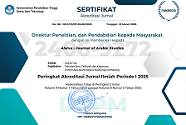Hypnoteaching dalam Pembelajaran Bahasa Arab
DOI:
https://doi.org/10.21580/alsina.5.1.18277Keywords:
Arabic learning, foreign language, hypnoteachingAbstract
Arabic Learning faces problems in the post-pandemic period. Students experience demotivation in learning so that learning outcomes decrease. For this reason, innovation with the hypnoteaching method is needed to provide positive suggestions and motivations so as to arouse enthusiasm for learning Arabic. The purpose of this study is to describe how educators apply hypnoteaching in Arabic learning. The method used is descriptive analysis or literature review that produces descriptive data from various research results about the experience of educators in implementing hypnoteaching in Arabic learning. Hypnoteaching is carried out with six steps, namely self-motivation, pacing, leading, using positive words, giving praise, and modelling. Basically, hypnoteaching makes the learning environment comfortable and conducive for students so that learning outcomes are optimal.
Downloads
References
Abuhaer, H. “Using Hypnoteaching Method to Improve Learning Motivation and Speaking Skill of The Students of SMAN 3 Pangkajene.” Qalam: Jurnal Ilmu Kependidikan 9, no. 2 (2021): 66–72.
Adams, John C., and Alan T. Seagren. “Distance Education Strategy: Mental Models and Strategic Choices.” Online Journal of Distance Learning Administration 7, no. 2 (2004). https://www.westga.edu/~distance/ojdla/summer72/adams72.html.
Adawiyah, Yayah Robiatul, Istibsyaroh Istibsyaroh, and Aulia Nuriyatir Rofi’ah. “Pembelajaran Bahasa Arab Berbasis Multikulturalisme Agama Melalui Metode Hypnoteaching.” Jurnal Review Pendidikan Dan Pengajaran 4, no. 1 (2021): 61–70. https://doi.org/10.31004/jrpp.v4i1.1721.
Akhsan, Akhsan, and Ahmadi Muhammadiyah. “Membangkitkan Potensi Diri dan Minat Siswa dalam Belajar Bahasa Arab dengan Nilai-Nilai Hypnoteaching.” Lahjah Arabiyah: Jurnal Bahasa Arab dan Pendidikan Bahasa Arab 2, no. 1 (2021): 40–51. https://doi.org/10.35316/lahjah.v2i1.1051.
Angger, Insia. “The Development of the Grammar Material on the Basis of the Entrance Hypnosis Educational ‘Hypnoteaching’ Android Program ‘Android’ in the Course of the Intensive Arabic Language Course ‘Al Farisi’ Pare Kadiri.” IJ-ATL (International Journal of Arabic Teaching and Learning) 2, no. 1 (2018): 62–79. https://doi.org/10.33650/ijatl.v2i1.289.
Anwar, Muhammad. “Menciptakan Pembelajaran Efektif Melalui Hupnoteaching.” Ekspose: Jurnal Penelitian Hukum Dan Pendidikan 16, no. 2 (2019): 469–81. https://doi.org/10.30863/ekspose.v16i2.106.
Ardiya, Ardiya, and Wandi Syahfutra. “The Implementation of Hypnoteaching Method in Increasing Motivation to Learn English for Senior High School in Pekanbaru.” ELT-Lectura 8, no. 1 (2021): 56–65. https://doi.org/10.31849/elt-lectura.v8i1.6218.
Arta wiguna, Ida bagus alit. “Efektivitas Penerapan Metode Hypnoteaching Dalam Meningkatkan Aktivitas Belajar Siswa.” PEMBELAJAR: Jurnal Ilmu Pendidikan, Keguruan, Dan Pembelajaran 4, no. 2 (2020): 66–75. https://doi.org/10.26858/pembelajar.v4i2.13006.
As’ari, Kasan. “Upaya Meningkatkan Hasil Belajar Pendidikan Agama Islam (PAI) Menggunakan Metode Hypnoteaching bagi Siswa Kelas VII C SMPN 1 Limbangan Kabupaten Kendal Tahun 2016/2017.” Al-Fikri: Jurnal Studi dan Penelitian Pendidikan Islam 1, no. 1 (2018): 22–40. https://doi.org/10.30659/jspi.v1i1.2428.
Baroroh, R Umi, and Abdul Kahfi Amrulloh. “Hypnoteaching Method in Arabic Learning.” Jurnal Al Bayan: Jurnal Jurusan Pendidikan Bahasa Arab 11, no. 1 (2019): 133–49. https://doi.org/10.24042/albayan.v11i1.3634.
Burhanuddin, Burhanuddin. “Problematika Pembelajaran bahasa Arab Berbasis Daring di Masa Pandemi COVID-19.” Zawiyah: Jurnal Pemikiran Islam 7, no. 2 (2021): 35–50. https://doi.org/10.31332/zjpi.v7i2.3388.
Cooper, Linn F., and David W. Rodgin. “Time Distortion in Hypnosis and Nonmotor Learning.” Science 115, no. 2992 (1952): 500–502. https://doi.org/10.1126/science.115.2992.500.
Fathurrohman, Pupuph. Strategi Belajar Dan Mengajar Melalui Penanaman Konsep Umum Dan Konsep Islam. Bandung: Refika Aditama, 2010.
Hajar, Ibnu. Hypnoteaching: Memaksimalkan Hasil Proses Belajar-Mengajar Dengan Hipnoterapi. Yogyakarta: Diva Press, 2011.
Hasan, Fuad, and Sukidin Sukidin. “Link and Match Between Hypnoteaching and Transformative Learning A Study Toward Practical Dimension in Learning.” Aksara: Jurnal Ilmu Pendidikan Nonformal 7, no. 2 (2021): 405–13. https://doi.org/10.37905/aksara.7.2.405-412.2021.
Hikmatillah, Qiya Khaira. “Al-Muqāranah bayna Ṭarīqat al-Īḥā’īyah wa-Ṭarīqat al-Maghnātīsī fī Taʿlīm al-Lughah l-ʿArabīyah.” Studi Arab 11, no. 2 (2020): 101–15. https://doi.org/10.35891/sa.v11i2.2463.
Istiani, Nurul, and Athoillah Islamy. “Hypnoteacing Sebagai Metode Alternatif Dalam Pembelajaran Materi Keagamaan.” SUSTAINABLE: Jurnal Kajian Mutu Pendidikan 3, no. 2 (2020): 53–61. https://doi.org/10.32923/kjmp.v3i2.1382.
Ja’faruddin, Ja’faruddin, Hamzah Upu, Chen Wen-Haw, and Daniel Chia-En Teng. “The Comparison between Two Hypnoteaching Models in Mathematics Teaching and Learning.” International Electronic Journal of Mathematics Education 15, no. 3 (2020): em0607. https://doi.org/10.29333/iejme/8480.
Kiftiah, Mariatul, Zamzam Rasyidi, and Akhmad Rusydi. “Pemanfaatan Hypnoteaching Dalam Meningkatkan Hasil Belajar Anak Bernilai Akademik Rendah.” PEDIAMU: Jurnal Ilmu Pendidikan, Keguruan, Dan Pembelajaran 1, no. 1 (2021): 45–51. https://doi.org/10.54443/pediamu.v1i1.4.
Lestari, Dian, and Abdullah Syarif. “Can the Hypnoteaching Method Increase Students’ Speaking Ability?” Elsya : Journal of English Language Studies 1, no. 3 (2020): 81–93. https://doi.org/10.31849/elsya.v1i3.5034.
Lismalinda, Lismalinda, and Moriyanti Moriyanti. “The Influence of Hypnoteaching Method on Students’ Reading Motivation and Achievement in Secondary School.” IJELTAL (Indonesian Journal of English Language Teaching and Applied Linguistics) 4, no. 1 (2019): 35–46. https://doi.org/10.21093/ijeltal.v4i1.286.
Ma’as Shobirin dan Taslim Syahlan. “Membangun Iklim Belajar Efektif Melalui Metode Hypnotheaching Di Madrasah Ibtidaiyah.” MAGISTRA:Jurnal Ilmu Pendidikan Dasar Dan Keislaman 9, no. 24 (2010).
Machmudah, Umi. Active Learning Dalam Pembelajaran Bahasa Arab. Malang: UIN-Malang Press, 2008.
Navis, Ali Akbar. Hypnoteaching: Revolusi Gaya Mengajar Untuk Melejitkan Prestasi Siswa. Yogyakarta: Ar-Ruzz Media, 2013.
Noer, Muhammad. Hypnoteaching for Success Learning. Yogyakarta: PT. Pustaka Insan Madani, 2010.
Pertiwi, Hana. Hypnoteaching untuk PAUD dan TK. Yogyakarta: Diva Press, 2014.
Rahma, Fathul, and Neviyarni Neviyarni. “Hypnoteaching Learning Theory Analysis in the Learning Process.” Journal of Counseling, Education and Society 2, no. 1 (2021): 7–13. https://doi.org/10.29210/08jces71300.
Rahmaniah, Rahmaniah, and Abdul Rohman. “The Teachers Exploring Students’ Speaking Skill Using Hypnoteaching.” Borneo Educational Journal (Borju) 2, no. 2 (2020): 68–73. https://doi.org/10.24903/bej.v2i2.628.
Rosmarie, Aprilia, and Mualimin Mualimin. “Improving Students’ Writing Skills and Motivation in Learning English at SMAN 2 Kediri Using Hypnoteaching Strategy.” Jurnal Ilmu Pendidikan 27, no. 1 (2021): 17–23. https://doi.org/10.17977/um048v27i1p17-22.
Setiadi, Agung Heru. “Penerapan Metode Hypnoteaching Untuk Mengembangkan Maharoh Al-Istima’ (Studi Eksperimen di IAIN Sultan Maulana Hasanuddin Banten).” Syaksia 19, no. 1 (2018): 13–36. https://doi.org/https://doi.org/10.37035/syakhsia.v17i1.1113.
———. “Penerapan Metode Hypnoteaching Untuk Mengembangkan Maharoh Al Kalam.” Al-Ahkam 14, no. 1 (2018): 63–90. https://doi.org/10.37035/ajh.v14i1.1482.
Shofihara, Inang Jalaludin. “Blended Learning, Solusi Penyelenggaraan Pendidikan Pakai Teknologi.” Kompas, 2022.
Sugiarti, Mimi. “Upaya Meningkatkan Hasil Belajar Pendidikan Agama Islam (PAI) Menggunakan Metode Hypnoteaching Bagi Siswa Kelas VIIC SMPN 29 Kaur.” GUAU: Jurnal Pendidikan Profesi Guru Agama Islam 2, no. 9 (2022): 255–66. http://studentjournal.iaincurup.ac.id/index.php/guau/article/view/765.
Supardi, Adi. “Pembelajaran Kursus Bahasa Arab Pada Era Pandemi Covid-19.” Taqdir 7, no. 2 (2022): 229–45. https://doi.org/10.19109/taqdir.v7i2.10022.
Susanto, Nanang Hasan, Wirda Ramadhanti, and Alyan Fatwa. “Implementasi Hypnoteaching dan Neuro Linguistik Programming (NLP) melalui Pendekatan Teori Maslow pada Peserta Didik.” International Journal of Human Computing Studies 3, no. 2 (2021): 171–81. https://doi.org/10.31149/ijhcs.v3i2.1638.
Syahas, Allika Nur Ramdina. “Physics Hypnoteaching: A Literatur Review.” Risenologi : Jurnal Sains, Teknologi, Sosial, Pendidikan, Dan Bahasa 4, no. 1 (2019): 15–24. https://doi.org/10.47028/j.risenologi.2019.41.87.
Syaifuddin, Muh, Ahmad Afiif, and Eka Damayanti. “Meningkatkan Hasil Belajar Peserta Didik Melalui Pembelajaran Metode Hypnoteaching.” Psikoislamika : Jurnal Psikologi Dan Psikologi Islam 16, no. 2 (2019): 39–45. https://doi.org/10.18860/psi.v16i2.8236.
Triwidia, Jaya Novian. Hypnoteaching: Bukan Sekedar Mengajar. Jakarta: D-Brain, 2010.
Uhr, Leonard. “Learning under Hypnosis: What Do We Know? What Should We Know?” Journal of Clinical and Experimental Hypnosis 6, no. 3 (1958): 121–35. https://doi.org/10.1080/00207145808407195.
Ulya Afif, Yusmicha. “Strategi Pembelajaran Materi PAI Dengan Metode Hypnoteaching Untuk Siswa Sekolah Dasar.” Ibriez : Jurnal Kependidikan Dasar Islam Berbasis Sains 6, no. 1 (2021): 92–103. https://doi.org/10.21154/ibriez.v6i1.158.
Wahid, Juliana, and Ratih Juni Astuti. “Penerapan Metode Hypnoteaching Dalam Upaya Meningkatkan Kecerdasan Otak Peserta Didik: Analisis Deskriptif Pada Peserta Didik Kelas IV Pada Sekolah Dasar Islam Al-Azhar 27 Cibinong.” Reslaj : Religion Education Social Laa Roiba Journal 2, no. 1 (2020): 67–92. https://doi.org/10.47467/reslaj.v2i1.136.
Wassalwa, Almanna, and Agung Wijaksono. “Meningkatkan Kekayaan Mufrodat Siswa Melalui Metode Hypnoteaching.” Lahjah Arabiyah: Jurnal Bahasa Arab Dan Pendidikan Bahasa Arab 1, no. 2 (2020): 53. https://doi.org/10.35316/lahjah.v1i2.820.
Wekke, Ismail Suwardi. Model Pembelajaran Bahasa Arab. Yogyakarta: Deepublish, 2014.
Wilton, Martha Cleveland-Innes dan Dan. Guide to Blended Learning. British Columbia: Commonwealth of Learning Press, 2018.
Young, Paul Campbell. “An Experimental Study of Mental and Physical Functions in the Normal and Hypnotic States.” The American Journal of Psychology 36, no. 2 (1925): 214–32. https://doi.org/10.2307/1413859.
Yustisia. Hypnoteaching. Yogyakarta: Ar-Ruzz Media, 2016.
Zainuddin, Muhammad. “Enhancing Students’ Motivation and Reading Achievement Trough Hypnoteaching Method in Class XI.” Journal of English Educational Study (JEES) 2, no. 2 (2019): 53–63. https://doi.org/10.31932/jees.v2i2.465.
Zuhri Dj, Muhammad, and Sukarnianti Sukarnianti. “Using Hypnoteaching Strategy to Improve Students’ Writing Ability.” Dinamika Ilmu 15, no. 2 (2015): 185–99. https://doi.org/10.21093/di.v15i2.101.
Downloads
Published
How to Cite
Issue
Section
License
Copyright
The copyright of the received article shall be assigned to the publisher of the journal. The intended copyright includes the right to publish the article in various forms (including reprints). The journal maintains the publishing rights to published articles. Authors are allowed to use their articles for any legal purposes deemed necessary without written permission from the journal, but with an acknowledgment to this journal of initial publication.
Licensing
In order for Alsina: Journal of Arabic Studies to publish and distribute research articles, the editors need publishing rights (transferred from author to publisher). This agreement relates to the transfer/publishing copyright license to Alsina: Journal of Arabic Studies but the authors still have significant rights to use and share their published articles.
Alsina: Journal of Arabic Studies supports the need for writers to share, disseminate and maximize the impact of their research and their rights on any database. As a journal article writer, you have the right to various uses of your articles, including that by the institution or company where you work. Copyright can be used without the need for special permission. Authors who publish articles in the Alsina: Journal of Arabic Studies have broad rights to use their work for teaching and scientific purposes without requesting permission, including:
- Use by the author for lectures, presentations, or conferences, with distribution of copies to participants;
- Distribution to colleagues for research use;
- Use in compilations of the author's subsequent work;
- inclusion in a thesis or dissertation;
- Reuse of sections or excerpts from articles in other works (with full acknowledgment of the final article);
- Preparation of derivative works (other than commercial purposes) (with full acknowledgment of the final article);
- Voluntary posting on open websites operated by authors’ or writers' agencies for scientific purposes
When submitting a manuscript, authors do so on the understanding that if accepted for publication, the copyright for publishing (publishing right) of the article shall be assigned/transferred to Alsina: Journal of Arabic Studies.
Authors whose articles are accepted for publication will receive confirmation via email and sent a Copyright Transfer Agreement.


 Accreditation
Accreditation 
 In Collaboration with
In Collaboration with 

 Visitors
Visitors  Article Template
Article Template





